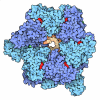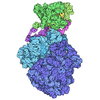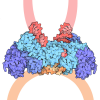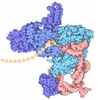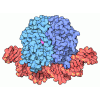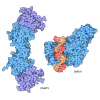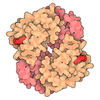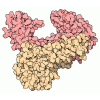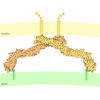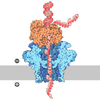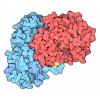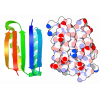[English] 日本語
 Yorodumi
Yorodumi- PDB-8xgc: Structure of yeast replisome associated with FACT and histone hex... -
+ Open data
Open data
- Basic information
Basic information
| Entry | Database: PDB / ID: 8xgc | ||||||
|---|---|---|---|---|---|---|---|
| Title | Structure of yeast replisome associated with FACT and histone hexamer, Composite map | ||||||
 Components Components |
| ||||||
 Keywords Keywords | REPLICATION / Replisome / FACT / histone hexamer | ||||||
| Function / homology |  Function and homology information Function and homology informationRegulation of TP53 Activity through Phosphorylation / : / regulation of sister chromatid cohesion / establishment of sister chromatid cohesion / DNA-templated DNA replication maintenance of fidelity / gene conversion / Unwinding of DNA / FACT complex / maintenance of DNA repeat elements / regulation of nuclear cell cycle DNA replication ...Regulation of TP53 Activity through Phosphorylation / : / regulation of sister chromatid cohesion / establishment of sister chromatid cohesion / DNA-templated DNA replication maintenance of fidelity / gene conversion / Unwinding of DNA / FACT complex / maintenance of DNA repeat elements / regulation of nuclear cell cycle DNA replication / DNA replication initiation / replication fork arrest / Cul8-RING ubiquitin ligase complex / meiotic chromosome segregation / HATs acetylate histones / RNA polymerase I upstream activating factor complex / Condensation of Prophase Chromosomes / SIRT1 negatively regulates rRNA expression / epsilon DNA polymerase complex / MCM core complex / Assembly of the pre-replicative complex / Switching of origins to a post-replicative state / DNA strand elongation involved in mitotic DNA replication / GINS complex / MCM complex binding / mitotic DNA replication preinitiation complex assembly / Activated PKN1 stimulates transcription of AR (androgen receptor) regulated genes KLK2 and KLK3 / nuclear DNA replication / regulation of chromatin organization / premeiotic DNA replication / Assembly of the ORC complex at the origin of replication / replication fork protection complex / HDACs deacetylate histones / pre-replicative complex assembly involved in nuclear cell cycle DNA replication / SUMO binding / anaphase-promoting complex binding / nucleotide-excision repair, DNA gap filling / Activation of the pre-replicative complex / mitotic DNA replication / CMG complex / DNA replication checkpoint signaling / establishment of mitotic sister chromatid cohesion / nuclear pre-replicative complex / DNA replication proofreading / nucleosome organization / Termination of translesion DNA synthesis / DNA replication preinitiation complex / Activation of ATR in response to replication stress / single-stranded DNA 3'-5' DNA exonuclease activity / MCM complex / Recruitment and ATM-mediated phosphorylation of repair and signaling proteins at DNA double strand breaks / mitotic DNA replication checkpoint signaling / Oxidative Stress Induced Senescence / double-strand break repair via break-induced replication / mitotic DNA replication initiation / RMTs methylate histone arginines / cellular response to osmotic stress / single-stranded DNA helicase activity / mitotic intra-S DNA damage checkpoint signaling / SUMOylation of chromatin organization proteins / silent mating-type cassette heterochromatin formation / Hydrolases; Acting on ester bonds; Exodeoxyribonucleases producing 5'-phosphomonoesters / regulation of DNA-templated DNA replication initiation / mitotic sister chromatid cohesion / TP53 Regulates Transcription of DNA Repair Genes / DNA strand elongation involved in DNA replication / nuclear chromosome / RNA Polymerase II Pre-transcription Events / 3'-5' DNA helicase activity / leading strand elongation / RNA Polymerase I Promoter Escape / mitotic G2 DNA damage checkpoint signaling / positive regulation of transcription by RNA polymerase I / nuclear replication fork / nucleolar large rRNA transcription by RNA polymerase I / replication fork processing / Estrogen-dependent gene expression / rRNA transcription / DNA replication origin binding / Dual incision in TC-NER / positive regulation of RNA polymerase II transcription preinitiation complex assembly / DNA replication initiation / positive regulation of transcription initiation by RNA polymerase II / error-prone translesion synthesis / Ub-specific processing proteases / subtelomeric heterochromatin formation / base-excision repair, gap-filling / telomere maintenance / DNA helicase activity / nuclear periphery / replication fork / meiotic cell cycle / transcription elongation by RNA polymerase II / helicase activity / base-excision repair / double-strand break repair via nonhomologous end joining / DNA-templated DNA replication / structural constituent of chromatin / nucleosome / heterochromatin formation Similarity search - Function | ||||||
| Biological species |  | ||||||
| Method | ELECTRON MICROSCOPY / single particle reconstruction / cryo EM / Resolution: 3.7 Å | ||||||
 Authors Authors | Li, N. / Gao, Y. / Yu, D. / Gao, N. / Zhai, Y. | ||||||
| Funding support |  China, 1items China, 1items
| ||||||
 Citation Citation |  Journal: Nature / Year: 2024 Journal: Nature / Year: 2024Title: Parental histone transfer caught at the replication fork. Authors: Ningning Li / Yuan Gao / Yujie Zhang / Daqi Yu / Jianwei Lin / Jianxun Feng / Jian Li / Zhichun Xu / Yingyi Zhang / Shangyu Dang / Keda Zhou / Yang Liu / Xiang David Li / Bik Kwoon Tye / ...Authors: Ningning Li / Yuan Gao / Yujie Zhang / Daqi Yu / Jianwei Lin / Jianxun Feng / Jian Li / Zhichun Xu / Yingyi Zhang / Shangyu Dang / Keda Zhou / Yang Liu / Xiang David Li / Bik Kwoon Tye / Qing Li / Ning Gao / Yuanliang Zhai /   Abstract: In eukaryotes, DNA compacts into chromatin through nucleosomes. Replication of the eukaryotic genome must be coupled to the transmission of the epigenome encoded in the chromatin. Here we report cryo- ...In eukaryotes, DNA compacts into chromatin through nucleosomes. Replication of the eukaryotic genome must be coupled to the transmission of the epigenome encoded in the chromatin. Here we report cryo-electron microscopy structures of yeast (Saccharomyces cerevisiae) replisomes associated with the FACT (facilitates chromatin transactions) complex (comprising Spt16 and Pob3) and an evicted histone hexamer. In these structures, FACT is positioned at the front end of the replisome by engaging with the parental DNA duplex to capture the histones through the middle domain and the acidic carboxyl-terminal domain of Spt16. The H2A-H2B dimer chaperoned by the carboxyl-terminal domain of Spt16 is stably tethered to the H3-H4 tetramer, while the vacant H2A-H2B site is occupied by the histone-binding domain of Mcm2. The Mcm2 histone-binding domain wraps around the DNA-binding surface of one H3-H4 dimer and extends across the tetramerization interface of the H3-H4 tetramer to the binding site of Spt16 middle domain before becoming disordered. This arrangement leaves the remaining DNA-binding surface of the other H3-H4 dimer exposed to additional interactions for further processing. The Mcm2 histone-binding domain and its downstream linker region are nested on top of Tof1, relocating the parental histones to the replisome front for transfer to the newly synthesized lagging-strand DNA. Our findings offer crucial structural insights into the mechanism of replication-coupled histone recycling for maintaining epigenetic inheritance. | ||||||
| History |
|
- Structure visualization
Structure visualization
| Structure viewer | Molecule:  Molmil Molmil Jmol/JSmol Jmol/JSmol |
|---|
- Downloads & links
Downloads & links
- Download
Download
| PDBx/mmCIF format |  8xgc.cif.gz 8xgc.cif.gz | 1.9 MB | Display |  PDBx/mmCIF format PDBx/mmCIF format |
|---|---|---|---|---|
| PDB format |  pdb8xgc.ent.gz pdb8xgc.ent.gz | Display |  PDB format PDB format | |
| PDBx/mmJSON format |  8xgc.json.gz 8xgc.json.gz | Tree view |  PDBx/mmJSON format PDBx/mmJSON format | |
| Others |  Other downloads Other downloads |
-Validation report
| Summary document |  8xgc_validation.pdf.gz 8xgc_validation.pdf.gz | 1.4 MB | Display |  wwPDB validaton report wwPDB validaton report |
|---|---|---|---|---|
| Full document |  8xgc_full_validation.pdf.gz 8xgc_full_validation.pdf.gz | 1.4 MB | Display | |
| Data in XML |  8xgc_validation.xml.gz 8xgc_validation.xml.gz | 243.6 KB | Display | |
| Data in CIF |  8xgc_validation.cif.gz 8xgc_validation.cif.gz | 379.6 KB | Display | |
| Arichive directory |  https://data.pdbj.org/pub/pdb/validation_reports/xg/8xgc https://data.pdbj.org/pub/pdb/validation_reports/xg/8xgc ftp://data.pdbj.org/pub/pdb/validation_reports/xg/8xgc ftp://data.pdbj.org/pub/pdb/validation_reports/xg/8xgc | HTTPS FTP |
-Related structure data
| Related structure data |  38317MC C: citing same article ( M: map data used to model this data |
|---|---|
| Similar structure data | Similarity search - Function & homology  F&H Search F&H Search |
- Links
Links
- Assembly
Assembly
| Deposited unit | 
|
|---|---|
| 1 |
|
- Components
Components
-DNA replication licensing factor ... , 5 types, 5 molecules 23467
| #1: Protein | Mass: 98911.539 Da / Num. of mol.: 1 / Source method: isolated from a natural source / Source: (natural)  |
|---|---|
| #2: Protein | Mass: 107653.508 Da / Num. of mol.: 1 / Source method: isolated from a natural source / Source: (natural)  |
| #3: Protein | Mass: 105138.375 Da / Num. of mol.: 1 / Source method: isolated from a natural source / Source: (natural)  |
| #5: Protein | Mass: 113110.211 Da / Num. of mol.: 1 / Source method: isolated from a natural source / Source: (natural)  |
| #6: Protein | Mass: 95049.875 Da / Num. of mol.: 1 / Source method: isolated from a natural source / Source: (natural)  |
-Protein , 10 types, 14 molecules 5EFGHIJKNROSPQ
| #4: Protein | Mass: 86505.734 Da / Num. of mol.: 1 / Source method: isolated from a natural source / Source: (natural)  | ||||||||||||||
|---|---|---|---|---|---|---|---|---|---|---|---|---|---|---|---|
| #13: Protein | Mass: 74324.836 Da / Num. of mol.: 1 / Source method: isolated from a natural source / Source: (natural)  | ||||||||||||||
| #14: Protein | Mass: 104543.391 Da / Num. of mol.: 3 / Source method: isolated from a natural source / Source: (natural)  #15: Protein | | Mass: 141296.875 Da / Num. of mol.: 1 / Source method: isolated from a natural source / Source: (natural)  #16: Protein | | Mass: 36402.590 Da / Num. of mol.: 1 / Source method: isolated from a natural source / Source: (natural)  #17: Protein | | Mass: 124516.375 Da / Num. of mol.: 1 / Source method: isolated from a natural source / Source: (natural)  #20: Protein | Mass: 15391.007 Da / Num. of mol.: 2 / Source method: isolated from a natural source / Source: (natural)  #21: Protein | Mass: 11395.390 Da / Num. of mol.: 2 / Source method: isolated from a natural source / Source: (natural)  #22: Protein | | Mass: 14013.177 Da / Num. of mol.: 1 / Source method: isolated from a natural source / Source: (natural)  #23: Protein | | Mass: 14264.341 Da / Num. of mol.: 1 / Source method: isolated from a natural source / Source: (natural)  |
-DNA polymerase epsilon ... , 2 types, 2 molecules 89
| #7: Protein | Mass: 255992.484 Da / Num. of mol.: 1 / Source method: isolated from a natural source / Source: (natural)  References: UniProt: P21951, DNA-directed DNA polymerase, Hydrolases; Acting on ester bonds; Exodeoxyribonucleases producing 5'-phosphomonoesters |
|---|---|
| #8: Protein | Mass: 78425.852 Da / Num. of mol.: 1 / Source method: isolated from a natural source / Source: (natural)  |
-DNA replication complex GINS protein ... , 4 types, 4 molecules ABCD
| #9: Protein | Mass: 24230.576 Da / Num. of mol.: 1 / Source method: isolated from a natural source / Source: (natural)  |
|---|---|
| #10: Protein | Mass: 29341.074 Da / Num. of mol.: 1 / Source method: isolated from a natural source / Source: (natural)  |
| #11: Protein | Mass: 21977.135 Da / Num. of mol.: 1 / Source method: isolated from a natural source / Source: (natural)  |
| #12: Protein | Mass: 33983.617 Da / Num. of mol.: 1 / Source method: isolated from a natural source / Source: (natural)  |
-FACT complex subunit ... , 2 types, 2 molecules LM
| #18: Protein | Mass: 118776.984 Da / Num. of mol.: 1 / Source method: isolated from a natural source / Source: (natural)  |
|---|---|
| #19: Protein | Mass: 63068.594 Da / Num. of mol.: 1 / Source method: isolated from a natural source / Source: (natural)  |
-DNA chain , 2 types, 2 molecules XY
| #24: DNA chain | Mass: 15689.072 Da / Num. of mol.: 1 / Source method: isolated from a natural source / Source: (natural)  |
|---|---|
| #25: DNA chain | Mass: 11935.764 Da / Num. of mol.: 1 / Source method: isolated from a natural source / Source: (natural)  |
-Non-polymers , 2 types, 12 molecules 
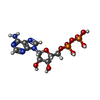

| #26: Chemical | ChemComp-ZN / #27: Chemical | ChemComp-ADP / |
|---|
-Details
| Has ligand of interest | Y |
|---|---|
| Has protein modification | Y |
-Experimental details
-Experiment
| Experiment | Method: ELECTRON MICROSCOPY |
|---|---|
| EM experiment | Aggregation state: PARTICLE / 3D reconstruction method: single particle reconstruction |
- Sample preparation
Sample preparation
| Component | Name: Endogenous replisomes / Type: COMPLEX / Entity ID: #1-#25 / Source: NATURAL |
|---|---|
| Source (natural) | Organism:  |
| Buffer solution | pH: 7.5 |
| Specimen | Embedding applied: NO / Shadowing applied: NO / Staining applied: NO / Vitrification applied: YES |
| Vitrification | Cryogen name: ETHANE |
- Electron microscopy imaging
Electron microscopy imaging
| Experimental equipment |  Model: Titan Krios / Image courtesy: FEI Company |
|---|---|
| Microscopy | Model: FEI TITAN KRIOS |
| Electron gun | Electron source:  FIELD EMISSION GUN / Accelerating voltage: 300 kV / Illumination mode: FLOOD BEAM FIELD EMISSION GUN / Accelerating voltage: 300 kV / Illumination mode: FLOOD BEAM |
| Electron lens | Mode: BRIGHT FIELD / Nominal defocus max: 2500 nm / Nominal defocus min: 1000 nm |
| Image recording | Electron dose: 50 e/Å2 / Film or detector model: GATAN K3 BIOQUANTUM (6k x 4k) |
- Processing
Processing
| CTF correction | Type: PHASE FLIPPING AND AMPLITUDE CORRECTION |
|---|---|
| 3D reconstruction | Resolution: 3.7 Å / Resolution method: FSC 0.143 CUT-OFF / Num. of particles: 524000 / Symmetry type: POINT |
 Movie
Movie Controller
Controller






 PDBj
PDBj